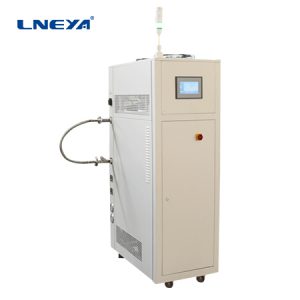Cooling heating and temperature control equipment for automotive battery test Chamber
The car battery testing chamber high and low temperature integrated machine is a testing equipment that integrates high and low temperature functions, specifically designed to evaluate the performance and durability of car batteries (such as lead-acid batteries, lithium-ion batteries, etc.) under simulated extreme temperature conditions.
This type of all-in-one machine can achieve a wide temperature range switching within a single device, allowing for comprehensive environmental adaptability testing without the need for device replacement. Its main features and uses include:
1.Wide temperature range coverage: High and low temperature all-in-one machines usually provide a wide temperature adjustment range, such as -40 ℃ to+80 ℃ (or even wider), to meet the performance evaluation needs of automotive batteries under various extreme weather conditions.
2.Rapid temperature change: With the ability to quickly increase and decrease temperature, it can reach the set temperature in a short time, improve testing efficiency, and is especially suitable for scenarios that require temperature cycling (such as thermal shock testing).
3.Accurate temperature control: Equipped with a high-precision temperature control system, it can accurately control and maintain the temperature stability inside the test box, ensuring the accuracy and consistency of test results.
4.Safety protection: Equipped with multiple safety protection measures, such as over temperature protection, over current protection, short circuit protection, etc., to ensure the safety of equipment and personnel during battery testing.
5.Automated testing: It can be combined with automated testing software to achieve automatic execution of testing programs, automatic data collection and analysis, simplify testing processes, and improve testing efficiency.
6.Compatible with multiple testing standards: capable of conducting high and low temperature performance tests on automotive batteries in accordance with relevant international or domestic standards (such as SAE, IEC, GB, etc.),
For example:
Low temperature performance test: Evaluate the cold start ability, capacity retention rate, charging acceptance, self discharge rate, etc. of the battery at low temperatures.
High temperature performance test: Check the capacity retention rate, charging efficiency, thermal stability, safety performance, etc. of the battery at high temperatures.
Temperature cycling test: Simulate the performance changes of batteries in rapidly changing temperature environments, such as the impact of thermal expansion and contraction on battery structure, and the temperature adaptability of battery management systems (BMS).
Durability testing: Conduct long-term charging and discharging cycles in high and low temperature environments to evaluate the battery’s cycle life, capacity degradation trend, electrochemical impedance changes, etc.
- Evaluate low-temperature starting performance: In cold climates, the battery must be able to provide sufficient electrical energy to start the vehicle engine. The test box simulates an extremely cold environment to verify the cold starting current (CCA) and cold starting ability of the battery at low temperatures.
- Measure capacity decay: Low temperature can affect the chemical reaction rate of the battery, leading to a decrease in battery capacity. By conducting charge and discharge tests in low-temperature environments, the actual available capacity of the battery under low-temperature conditions can be quantified, and its endurance in cold weather can be evaluated.
- Check the charging acceptance characteristics: At low temperatures, the charging efficiency of the battery may decrease, and there may be a problem of decreased charging acceptance ability. The test box can simulate low-temperature charging conditions, check whether the battery can charge normally, and evaluate its charging time, charging efficiency, and safety.
- Evaluate cold resistance and lifespan: Long term exposure to low temperatures may accelerate battery aging or cause internal failures. The test box can simulate long-term low-temperature storage or usage conditions, evaluate the durability and expected lifespan of batteries at low temperatures.
- Detection of safety characteristics: Low temperatures may trigger certain internal failure modes of the battery, such as increased risk of thermal runaway.The test chamber can be used for abuse testing under low temperature conditions (such as overcharging, short circuit, etc.) to verify the effectiveness of the battery’s safety protection mechanism.
The application scenarios of the high and low temperature integrated machine for automotive battery testing boxes are wide, which is suitable for performance verification of new products in the battery development stage, as well as quality control and factory inspection in the production stage, as well as fault diagnosis and analysis in the after-sales market. Through the testing of such devices, key data support can be provided for the performance optimization, reliability improvement, and market access of automotive batteries.
loading…
已经是到最后一篇内容了!
Related recommendations
-
KRY -25℃~+100℃
3192Temperature range is -25℃~+100℃, which can be extended to +135℃ according to the actual situation, and the temperature control accuracy is plus or minus 0.5℃. The equipment can control the flow and pressure independently w...
View details -
KRY -20℃~+100℃ (1to6)
2946The System Process Flow Is As Follows: The liquid refrigerant in the evaporator of the unit is exchanged with the circulating air in the interior of the tank. The temperature rises from liquid to gas, and is sucked into th...
View details -
What tests are used by cooling water chillers for new energy enterprises?
1352In the process of product development, production and quality control, new energy enterprises will use cooling water chillers to perform a variety of tests. Cooling water chillers play an important role in these tests to ensure the perform...
View details -
What should you pay attention to when installing a DC charging pile cooling system?
1349pay attention to when installing a DC charging pile cooling system
View details
 LNEYA Industrial Chillers Manufacturer Supplier
LNEYA Industrial Chillers Manufacturer Supplier












